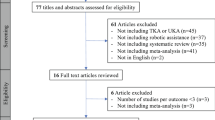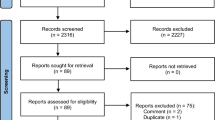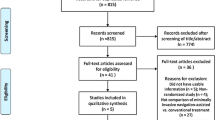Abstract
Purpose
To achieve the desired alignment more accurately and improve postoperative outcomes, new techniques such as computer navigation (Navigation), patient-specific instruments (PSI) and surgical robots (Robot) are applied in Total Knee Arthroplasty (TKA). This network meta-analysis aims to compare the radiological and clinical outcomes among the above-mentioned techniques and conventional instruments (CON).
Methods
A PRISMA network meta-analysis was conducted and study protocol was published online at INPLASY (INPLASY202060018). Three databases (PubMed, EMBASE and Cochrane) were searched up to June 1, 2020. Randomised controlled trials (RCTs) comparing any two of the four techniques were included. A Bayesian network meta-analysis was performed focusing on radiological and clinical outcomes. The odds ratio (OR) or mean difference (MD) in various outcomes were calculated, and the interventions were ranked by the surface under the cumulative ranking area (SUCRA) value.
Results
Seventy-three RCTs were included, with a total of 4209 TKAs. Navigation and Robot could significantly reduce the occurrence of malalignment and malposition compared with PSI and CON, and Navigation could obtain higher medium-and-long-term KSS knee scores than CON. Robot had the greatest advantage in achieving the desired alignment accurately, followed by Navigation; Navigation had the greatest advantage in the KSS score.
Conclusion
Navigation and Robot did improve the accuracy of alignment compared with PSI and conventional instrument in TKA, but the above four techniques showed no clinical significance in postoperative outcomes.
Level of evidence
I



Similar content being viewed by others
Abbreviations
- TKA:
-
Total knee arthroplasty
- Navigation:
-
Computer navigation
- Robot:
-
Surgical robots
- PSI:
-
Patient-specific instruments
- CON:
-
Conventional TKA
- NMA:
-
Network meta-analysis
- RCTs:
-
Randomised controlled trials
- OR:
-
Odds ratio
- MD:
-
Mean difference
- SUCRA:
-
Surface under the cumulative ranking area
- PROM:
-
Patient-reported outcome measures
- MCID:
-
Minimal clinically important difference
- KSS:
-
Knee Society Knee Scoring System
- WOMAC:
-
Western Ontario and McMaster University osteoarthritis index scores
References
Agarwal N, To K, McDonnell S, Khan W (2020) Clinical and radiological outcomes in robotic-assisted total knee arthroplasty: a systematic review and meta-analysis. J Arthroplasty 35:3393-3409.e3392
Chin BZ, Tan SSH, Chua KCX, Budiono GR, Syn NL, O’Neill GK (2020) Robot-assisted versus conventional total and unicompartmental knee arthroplasty: a meta-analysis of radiological and functional outcomes. J Knee Surg. https://doi.org/10.1055/s-0040-1701440
Chun YS, Kim KI, Cho YJ, Kim YH, Yoo MC, Rhyu KH (2011) Causes and patterns of aborting a robot-assisted arthroplasty. J Arthroplasty 26:621–625
Cucchi D, Menon A, Compagnoni R, Ferrua P, Fossati C, Randelli P (2018) Significant differences between manufacturer and surgeon in the accuracy of final component size prediction with CT-based patient-specific instrumentation for total knee arthroplasty. Knee Surg Sports Traumatol Arthrosc 26:3317–3324
Ewald FC (1989) The Knee Society total knee arthroplasty roentgenographic evaluation and scoring system. Clin Orthop Relat Res 248:9–12
Gong S, Xu W, Wang R, Wang Z, Wang B, Han L et al (2019) Patient-specific instrumentation improved axial alignment of the femoral component, operative time and perioperative blood loss after total knee arthroplasty. Knee Surg Sports Traumatol Arthrosc 27:1083–1095
Hutton B, Salanti G, Caldwell DM, Chaimani A, Schmid CH, Cameron C et al (2015) The PRISMA extension statement for reporting of systematic reviews incorporating network meta-analyses of health care interventions: checklist and explanations. Ann Intern Med 162:777–784
Insall JN, Dorr LD, Scott RD, Scott WN (1989) Rationale of the Knee Society clinical rating system. Clin Orthop Relat Res 248:13–14
Jones CW, Jerabek SA (2018) Current role of computer navigation in total knee arthroplasty. J Arthroplasty 33:1989–1993
Khera R, Murad MH, Chandar AK, Dulai PS, Wang Z, Prokop LJ et al (2016) Association of pharmacological treatments for obesity with weight loss and adverse events: a systematic review and meta-analysis. JAMA 315:2424–2434
Khlopas A, Sodhi N, Sultan AA, Chughtai M, Molloy RM, Mont MA (2018) Robotic arm-assisted total knee arthroplasty. J Arthroplasty 33:2002–2006
Kim YH, Park JW, Kim JS, Park SD (2014) The relationship between the survival of total knee arthroplasty and postoperative coronal, sagittal and rotational alignment of knee prosthesis. Int Orthop 38:379–385
Kizaki K, Shanmugaraj A, Yamashita F, Simunovic N, Duong A, Khanna V et al (2019) Total knee arthroplasty using patient-specific instrumentation for osteoarthritis of the knee: a meta-analysis. BMC Musculoskelet Disord 20:561
Lee DY, Park YJ, Hwang SC, Park JS, Kang DG (2020) No differences in mid- to long-term outcomes of computer-assisted navigation versus conventional total knee arthroplasty. Knee Surg Sports Traumatol Arthrosc 28:3183–3192
Lee WC, Kwan YH, Chong HC, Yeo SJ (2017) The minimal clinically important difference for Knee Society Clinical Rating System after total knee arthroplasty for primary osteoarthritis. Knee Surg Sports Traumatol Arthrosc 25:3354–3359
Levy YD, An VVG, Shean CJW, Groen FR, Walker PM, Bruce WJM (2017) The accuracy of bony resection from patient-specific guides during total knee arthroplasty. Knee Surg Sports Traumatol Arthrosc 25:1678–1685
Lin Y, Cai W, Xu B, Li J, Yang Y, Pan X et al (2020) Patient-specific or conventional instrumentations: a meta-analysis of randomized controlled trials. Biomed Res Int 2020:2164371
Liow MHL, Goh GS, Wong MK, Chin PL, Tay DK, Yeo SJ (2017) Robotic-assisted total knee arthroplasty may lead to improvement in quality-of-life measures: a 2-year follow-up of a prospective randomized trial. Knee Surg Sports Traumatol Arthrosc 25:2942–2951
Lizaur-Utrilla A, Gonzalez-Parreño S, Martinez-Mendez D, Miralles-Muñoz FA, Lopez-Prats FA (2020) Minimal clinically important differences and substantial clinical benefits for Knee Society Scores. Knee Surg Sports Traumatol Arthrosc 28:1473–1478
Longstaff LM, Sloan K, Stamp N, Scaddan M, Beaver R (2009) Good alignment after total knee arthroplasty leads to faster rehabilitation and better function. J Arthroplasty 24:570–578
Lonner JH, Fillingham YA (2018) Pros and Cons: a balanced view of robotics in knee arthroplasty. J Arthroplasty 33:2007–2013
Lumley T (2002) Network meta-analysis for indirect treatment comparisons. Stat Med 21:2313–2324
Mannan A, Akinyooye D, Hossain F (2017) A meta-analysis of functional outcomes in patient-specific instrumented knee arthroplasty. J Knee Surg 30:668–674
Matsuda S, Kawahara S, Okazaki K, Tashiro Y, Iwamoto Y (2013) Postoperative alignment and ROM affect patient satisfaction after TKA. Clin Orthop Relat Res 471:127–133
Mullaji A, Lingaraju AP, Shetty GM (2012) Computer-assisted total knee replacement in patients with arthritis and a recurvatum deformity. J Bone Jt Surg Br 94:642–647
Mullaji AB, Shetty GM (2014) Correction of varus deformity during TKA with reduction osteotomy. Clin Orthop Relat Res 472:126–132
Mullaji AB, Shetty GM (2010) Lateral epicondylar osteotomy using computer navigation in total knee arthroplasty for rigid valgus deformities. J Arthroplasty 25:166–169
Mullaji AB, Shetty GM (2013) Surgical technique: computer-assisted sliding medial condylar osteotomy to achieve gap balance in varus knees during TKA. Clin Orthop Relat Res 471:1484–1491
Onggo JR, Onggo JD, De Steiger R, Hau R (2020) Robotic-assisted total knee arthroplasty is comparable to conventional total knee arthroplasty: a meta-analysis and systematic review. Arch Orthop Trauma Surg 140:1533–1549
Panjwani TR, Mullaji A, Doshi K, Thakur H (2019) Comparison of functional outcomes of computer-assisted vs conventional total knee arthroplasty: a systematic review and meta-analysis of high-quality, prospective studies. J Arthroplasty 34:586–593
Panni AS, Ascione F, Rossini M, Braile A, Corona K, Vasso M et al (2018) Tibial internal rotation negatively affects clinical outcomes in total knee arthroplasty: a systematic review. Knee Surg Sports Traumatol Arthrosc 26:1636–1644
Pietsch M, Djahani O, Hochegger M, Plattner F, Hofmann S (2013) Patient-specific total knee arthroplasty: the importance of planning by the surgeon. Knee Surg Sports Traumatol Arthrosc 21:2220–2226
Rebal BA, Babatunde OM, Lee JH, Geller JA, Patrick DA Jr, Macaulay W (2014) Imageless computer navigation in total knee arthroplasty provides superior short term functional outcomes: a meta-analysis. J Arthroplasty 29:938–944
Rhee SJ, Kim HJ, Lee CR, Kim CW, Gwak HC, Kim JH (2019) A comparison of long-term outcomes of computer-navigated and conventional total knee arthroplasty: a meta-analysis of randomized controlled trials. J Bone Jt Surg Am 101:1875–1885
Ritter MA, Davis KE, Meding JB, Pierson JL, Berend ME, Malinzak RA (2011) The effect of alignment and BMI on failure of total knee replacement. J Bone Jt Surg Am 93:1588–1596
Sassoon A, Nam D, Nunley R, Barrack R (2015) Systematic review of patient-specific instrumentation in total knee arthroplasty: new but not improved. Clin Orthop Relat Res 473:151–158
Slevin O, Hirschmann A, Schiapparelli FF, Amsler F, Huegli RW, Hirschmann MT (2018) Neutral alignment leads to higher knee society scores after total knee arthroplasty in preoperatively non-varus patients: a prospective clinical study using 3D-CT. Knee Surg Sports Traumatol Arthrosc 26:1602–1609
Stronach BM, Pelt CE, Erickson J, Peters CL (2013) Patient-specific total knee arthroplasty required frequent surgeon-directed changes. Clin Orthop Relat Res 471:169–174
Swank ML, Alkire M, Conditt M, Lonner JH (2009) Technology and cost-effectiveness in knee arthroplasty: computer navigation and robotics. Am J Orthop (Belle Mead NJ) 38:32–36
Thienpont E, Schwab PE, Fennema P (2017) Efficacy of patient-specific instruments in total knee arthroplasty: a systematic review and meta-analysis. J Bone Jt Surg Am 99:521–530
van der List JP, Chawla H, Joskowicz L, Pearle AD (2016) Current state of computer navigation and robotics in unicompartmental and total knee arthroplasty: a systematic review with meta-analysis. Knee Surg Sports Traumatol Arthrosc 24:3482–3495
Woolson ST, Harris AH, Wagner DW, Giori NJ (2014) Component alignment during total knee arthroplasty with use of standard or custom instrumentation: a randomized clinical trial using computed tomography for postoperative alignment measurement. J Bone Jt Surg Am 96:366–372
Funding
There was no financial conflict of interest with regards to this study.
Author information
Authors and Affiliations
Contributions
XC and KL composed the manuscript; LML and KL participated in the search, data extraction and quality assessment work; QF and KL completed the statistical analysis; LG and LY conceived the idea of the study. All the authors contributed to the writing of the manuscript and approved the final manuscript.
Corresponding author
Ethics declarations
Conflict of interest
All the authors declare that they have no conflict of interest.
Ethical approval
This article does not contain any studies with human participants or animals performed by any of the authors, and thus, ethical approval was not required.
Additional information
Publisher's Note
Springer Nature remains neutral with regard to jurisdictional claims in published maps and institutional affiliations.
Supplementary Information
Below is the link to the electronic supplementary material.
Rights and permissions
About this article
Cite this article
Lei, K., Liu, L., Chen, X. et al. Navigation and robotics improved alignment compared with PSI and conventional instrument, while clinical outcomes were similar in TKA: a network meta-analysis. Knee Surg Sports Traumatol Arthrosc 30, 721–733 (2022). https://doi.org/10.1007/s00167-021-06436-8
Received:
Accepted:
Published:
Issue Date:
DOI: https://doi.org/10.1007/s00167-021-06436-8




